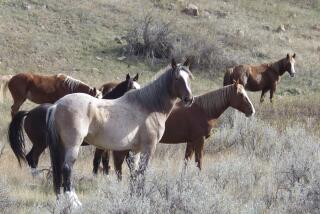Snowmobile Plan Defies Findings
- Share via
The Bush administration chose to expand snowmobile use in Yellowstone and Grand Teton national parks despite findings by its own National Park Service that the vehicles cause environmental and health damage, according to documents released Thursday.
Snowmobiles were scheduled to be phased out of the parks this year under a rule imposed late in the Clinton administration. But after President Bush took office, the ban was overturned and replaced in November by a plan allowing up to 35% more snowmobiles into the parks than visit on a typical day.
Bush administration officials, citing a cleaner, quieter generation of snowmobiles, chose their plan from among five proposals. The option that would have banned the machines -- echoing the scientific findings of the previous administration -- was made public Thursday by the Greater Yellowstone Coalition, an environmental group.
Snowmobile critics say the Bush administration study -- part of the parks’ Final Supplemental Environmental Impact Statement -- supports 10 years of scientific analysis that concluded the machines created unhealthy levels of noise and air pollution and led to President Clinton’s order to phase them out.
“They’ve been telling the American people one thing, while they know another, based on their own data,” said Jon Catton of the Greater Yellowstone Coalition. “They’ve been saying the new generation of snowmobiles will make all the difference when they know they won’t.”
The study concludes that phasing out snowmobiles “best preserves the unique historic, cultural, and natural resources” in the parks. The National Park Service found that banning the machines “yields the lowest levels of impacts to air quality, water quality, natural soundscapes, and wildlife.”
Snowmobile manufacturers say newer four-stroke engines are less noisy and do not pollute as much as older two-stroke models.
Advocates have also questioned some scientific findings that conclude snowmobile users harass wildlife and harm air quality.
The $2.4-million environmental impact study found that the National Park Service proposal to reverse the ban would cause haze and visibility impairment at Old Faithful, a popular destination for snowmobilers in Yellowstone.
John Sacklin, Yellowstone’s chief of planning, said the park is required to include an environmental alternative among the various proposals but is under no obligation to adopt it as policy.
“It is not the first time that we in Yellowstone have identified a preferred alternative that’s different from the environmentally preferred alternative,” Sacklin said. “As an agency we look at the preferred alternative to strike a balance” among snowmobilers, cross-country skiers and other visitors.
But to former Yellowstone Supt. Mike Finley, the policy favors the interests of snowmobilers. “This administration is making a decision based on the best short-term interest of the snowmobile industry and machine renter,” Finley said.
The snowmobile issue has been a contentious one for the National Park Service. The agency received more public comments about snowmobiles in Yellowstone than any other issue in its history. About 80% of respondents favored a ban.
Until recently, the National Park Service had agreed -- issuing the ban after 10 years of study and following recommendations from the Environmental Protection Agency and the Occupational Safety and Health Administration.
The ban was to take effect this year.
Visitors and employees have complained about noise and fumes from the machines. Park rangers at entrance stations wear respirators and work in kiosks that require fresh air to be pumped in. This season some rangers will be fitted with sophisticated hearing protection.
But Yellowstone officials maintain that cleaner, quieter machines will make those measures unnecessary. The new plan would require that 80% of the snowmobiles entering the park be led by commercial guides using the new-generation engines.
The general public would be able to enter the park on two-stroke engines until the 2004-05 season.
Yellowstone officials said noise and air pollution monitors would be placed around the park to gauge the new snowmobiles’ effects. Yellowstone has a goal of reducing hydrocarbons by 90% and carbon monoxide by 70%.
The proposed winter management plan for Yellowstone, neighboring Grand Teton National Park and John D. Rockefeller Jr. Memorial Parkway is scheduled to go into effect in March.
More to Read
Sign up for Essential California
The most important California stories and recommendations in your inbox every morning.
You may occasionally receive promotional content from the Los Angeles Times.











